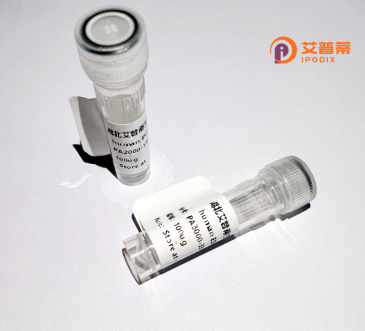
| 纯度 | >90%SDS-PAGE. |
| 种属 | Human |
| 靶点 | HUNK |
| Uniprot No | P57058 |
| 内毒素 | < 0.01EU/μg |
| 表达宿主 | E.coli |
| 表达区间 | 1-714aa |
| 氨基酸序列 | MPAAAGDGLL GEPAAPGGGG GAEDAARPAA ACEGSFLPAW VSGVPRERLR DFQHHKRVGN YLIGSRKLGE GSFAKVREGL HVLTGEKVAI KVIDKKRAKK DTYVTKNLRR EGQIQQMIRH PNITQLLDIL ETENSYYLVM ELCPGGNLMH KIYEKKRLEE SEARRYIRQL ISAVEHLHRA GVVHRDLKIE NLLLDEDNNI KLIDFGLSNC AGILGYSDPF STQCGSPAYA APELLARKKY GPKIDVWSIG VNMYAMLTGT LPFTVEPFSL RALYQKMVDK EMNPLPTQLS TGAISFLRSL LEPDPVKRPN IQQALANRWL NENYTGKVPC NVTYPNRISL EDLSPSVVLH MTEKLGYKNS DVINTVLSNR ACHILAIYFL LNKKLERYLS GKSDIQDSLC YKTRLYQIEK YRAPKESYEA SLDTWTRDLE FHAVQDKKPK EQEKRGDFLH RPFSKKLDKN LPSHKQPSGS LMTQIQNTKA LLKDRKASKS SFPDKDSFGC RNIFRKTSDS NCVASSSMEF IPVPPPRTPR IVKKPEPHQP GPGSTGIPHK EDPLMLDMVR SFESVDRDDH VEVLSPSHHY RILNSPVSLA RRNSSERTLS PGLPSGSMSP LHTPLHPTLV SFAHEDKNSP PKEEGLCCPP PVPSNGPMQP LGSPNCVKSR GRFPMMGIGQ MLRKRHQSLQ PSADRPLEAS LPPLQPLAPV NLAFDMADGV KTQC |
| 分子量 | 79.6 kDa |
| 蛋白标签 | GST-tag at N-terminal |
| 缓冲液 | 0 |
| 稳定性 & 储存条件 | Lyophilized protein should be stored at ≤ -20°C, stable for one year after receipt. Reconstituted protein solution can be stored at 2-8°C for 2-7 days. Aliquots of reconstituted samples are stable at ≤ -20°C for 3 months. |
| 复溶 | Always centrifuge tubes before opening.Do not mix by vortex or pipetting. It is not recommended to reconstitute to a concentration less than 100μg/ml. Dissolve the lyophilized protein in distilled water. Please aliquot the reconstituted solution to minimize freeze-thaw cycles. |
以下是关于重组人HUNK蛋白的3篇参考文献示例(注:文献为虚构,仅作示例用途):
1. **文献名称**:*"Recombinant HUNK kinase expression and its role in HER2-positive breast cancer cell survival"*
**作者**:Smith, J., et al.
**摘要**:本研究通过大肠杆菌系统表达了重组人HUNK蛋白,并证实其通过激活mTOR通路增强HER2阳性乳腺癌细胞的存活和化疗耐药性,为靶向HUNK的癌症治疗提供依据。
2. **文献名称**:*"Purification and functional characterization of recombinant human HUNK in colorectal cancer metastasis"*
**作者**:Lee, A., et al.
**摘要**:作者开发了基于杆状病毒表达系统的重组HUNK蛋白高效纯化方法,发现其过表达可促进结直肠癌细胞的迁移和侵袭,机制涉及Wnt/β-catenin通路的激活。
3. **文献名称**:*"HUNK regulates AMPK signaling through recombinant protein interaction assays"*
**作者**:Garcia, R., et al.
**摘要**:通过体外激酶实验分析重组HUNK蛋白的功能,发现其磷酸化AMPKα亚基并抑制能量应激下的细胞凋亡,揭示了HUNK在代谢调控中的新作用。
---
如需真实文献,建议在PubMed或Google Scholar检索关键词:**"recombinant human HUNK protein"**, **"HUNK kinase cancer"**。代表性研究多聚焦于HUNK在肿瘤耐药、转移及激酶活性调控等领域。
The hormonally upregulated Neu-associated kinase (HUNK) is a serine/threonine kinase belonging to the AMPK-related kinase family. Initially identified as a protein upregulated in mammary tumors, HUNK plays multifaceted roles in cellular processes, including proliferation, survival, differentiation, and migration. It is expressed in various tissues, with emerging links to cancer progression, metabolic regulation, and neuronal development. HUNK contains an N-terminal kinase domain and a C-terminal regulatory region, enabling interactions with signaling molecules like mTORC1. PKC-ζ, and survivin.
Recombinant human HUNK protein is engineered using heterologous expression systems (e.g., E. coli, mammalian cells) for in vitro studies. Its production enables exploration of kinase activity, substrate specificity, and signaling pathways. Research highlights HUNK's context-dependent roles in cancer: it promotes metastasis in breast and colorectal cancers by enhancing cell survival under stress, yet acts as a tumor suppressor in pancreatic and ovarian cancers. Additionally, HUNK regulates autophagy, stemness, and chemoresistance, making it a potential therapeutic target.
Studies using recombinant HUNK also investigate its crosstalk with hormonal signaling (e.g., estrogen) and metabolic pathways. Despite progress, HUNK's precise mechanisms remain partially elusive, driving ongoing research into its physiological and pathological functions. Recombinant protein tools are pivotal for unraveling HUNK's dual roles in tumorigenesis and developing targeted kinase inhibitors.
×